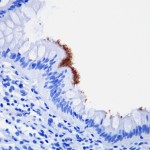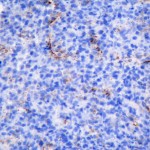El anticuerpo policlonal “Espiroqueta (Treponema pallidum)” permite la identificación por inmunohistoquímica del agente etiológico de la sífilis, sobre tejido fijado en formol e incluido en parafina, proporcionando mayor sensibilidad y especificidad que las técnicas histoquímicas clásicas de impregnación argéntica (Steiner, Warthin-Starry).
BIBLIOGRAFÍA
- Quatresooz P et al. Skin homing of Treponema pallidum in early syphilis and immunohistochemical study. Appl Immunohistochem Mol Morphol. 2009,17:47-50
- Quatresooz P et al. La syphilis, la grande simunatrice démasquée. Dermatol Atual. 2007,104:6-10
- Hoang MP et al. Secondary syphilis: a histologic and immunohiochemical evaluation. J Cutan Pathol. 2004,31:595-9
- Phelps RG et al. Immunoperoxidase technique por detecting spirochetes in tissue sections: comparison with other methods. Int J Dermatol. 2000,39:609-13
- Lee WS et al. Detection of Treponema pallidum in tissue: a comparative study of the avidin-biotin-peroxidase-complex, indirect immunoperoxidase, FTA-ABS complement techniques and darkfield method. Yonsei Med J. 1991,32:335-9
- Beckett JH et al. Immunoperoxidase localization of Treponema pallidum: its use in formaldehyde-fixed and paraffin-embedded tissue sections. Arch Pathol Lab Med. 1979,103(3):135-8
07/2009/ M. Verdú


